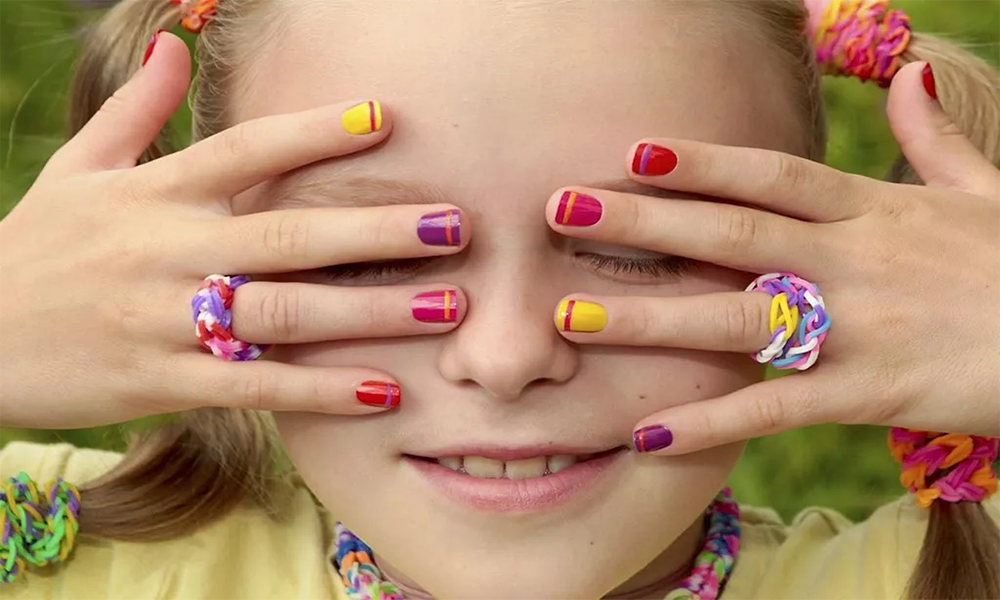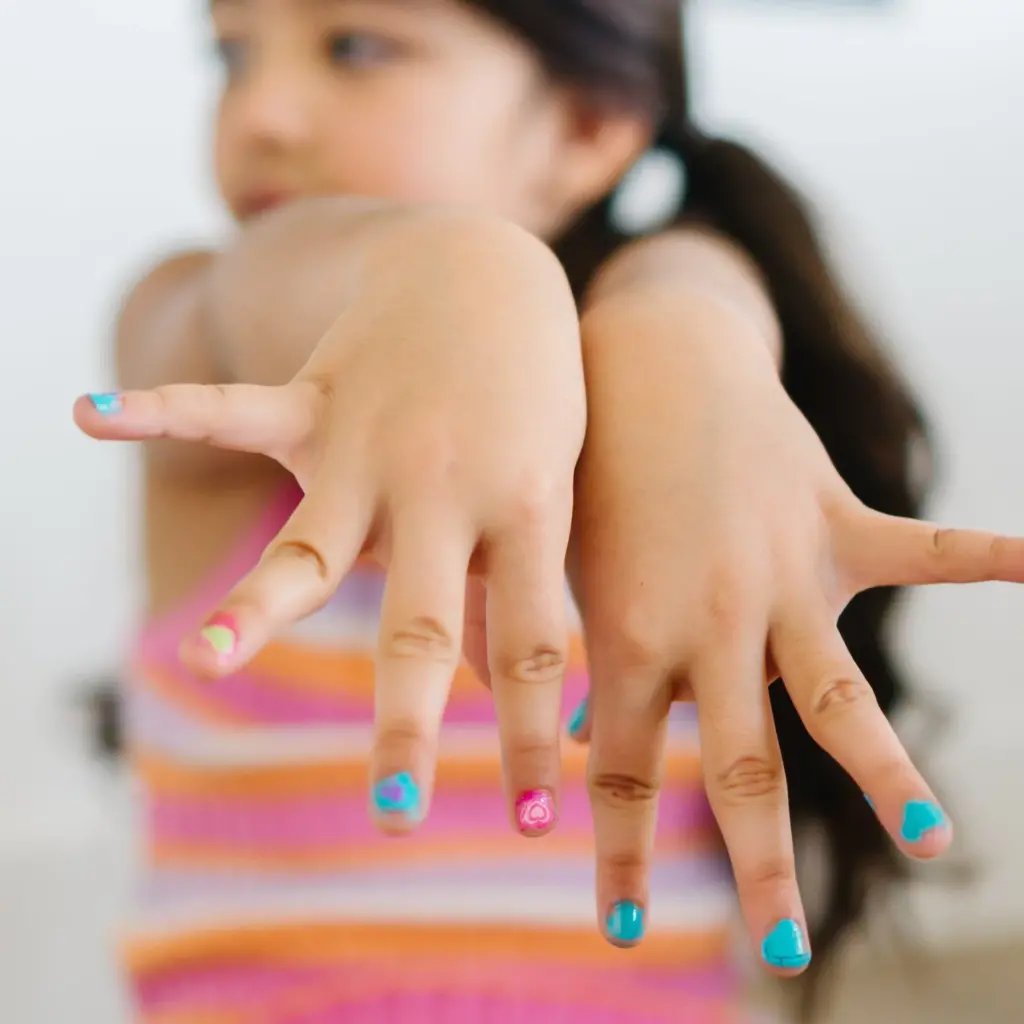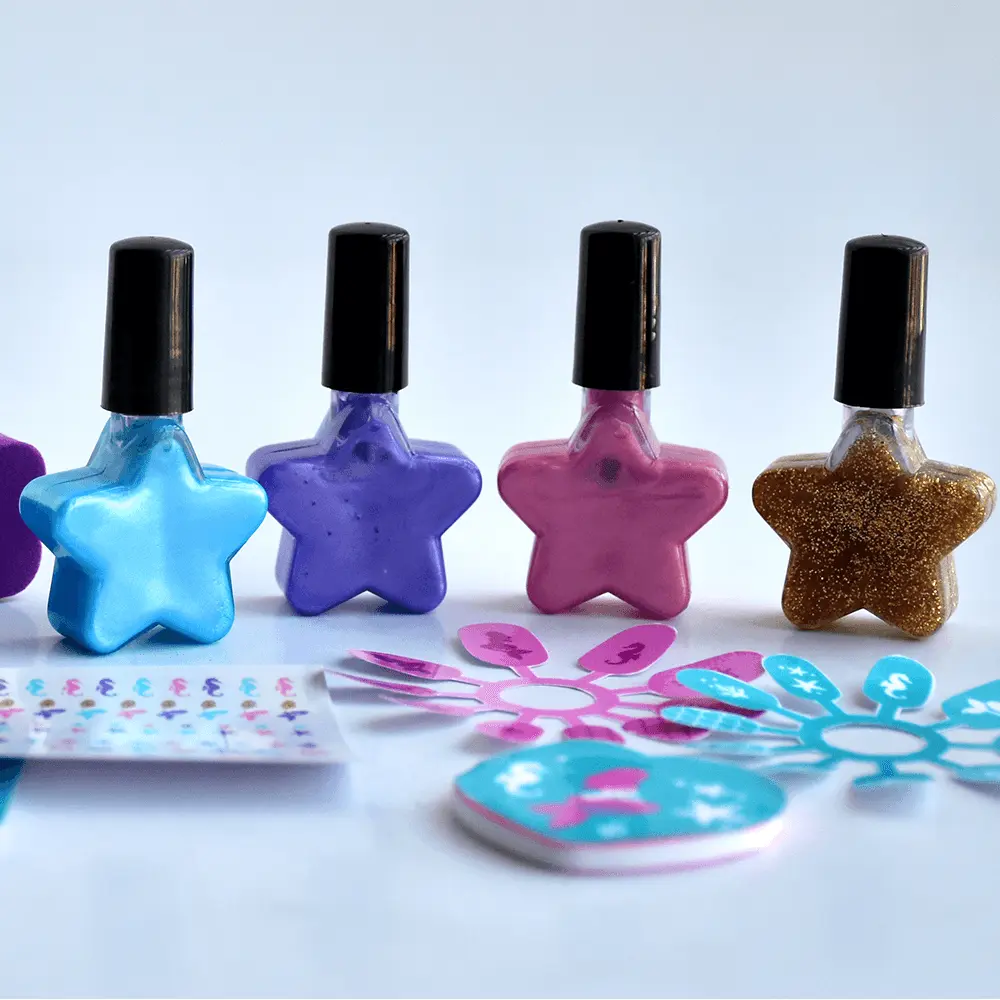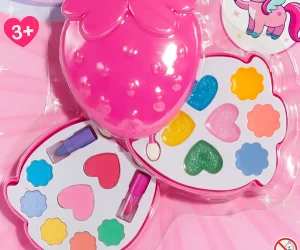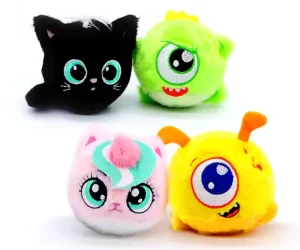What Nail Polish to Use on Kids? A Safe and Fun Guide
Table of Contents
Wondering what nail polish is safe for children? Get expert tips on kid-friendly formulas, application safety, and ingredient awareness.
Why Choosing the Right Nail Polish for Kids Matters
Kids are not just smaller adults. Their skin is thinner, their nails softer, and their behaviors—like thumb-sucking or nail-biting—are more common. Because of this, choosing the right nail polish for kids isn’t just about color. It’s a safety issue.
Some parents might assume that all nail polish is harmless. But adult formulas often contain solvents and preservatives that can irritate or harm developing skin. If a child accidentally ingests chipped polish—or simply touches their mouth with painted fingers—it raises concern.
Children also absorb chemicals faster than adults. According to the American Academy of Pediatrics, children’s skin absorbs substances more readily due to a higher surface-area-to-body-weight ratio (AAP, 2016). That makes ingredient safety even more important when selecting nail polish for kids.
Children’s Skin and Nail Differences Compared to Adults
A child’s nail plate is thinner and more porous. Their nails grow faster, too. That means any harsh or drying ingredient in nail polish can cause brittleness or flaking within days.
A mom in Minnesota noticed her five-year-old’s nails peeling after using her own polish during a playdate. The polish wasn’t labeled for kids. Within a week, her daughter’s nails had become dull and soft. This wasn’t an allergic reaction—just a mismatch between product and biology.
The skin around kids’ nails also lacks the oil barrier that protects adults. So even light exposure to strong polish removers can dry or crack the surrounding skin, leading to discomfort or itching.
Common Reactions to Harsh Nail Ingredients
Reactions to nail polish ingredients are not rare in children. Symptoms may include redness around the nail, peeling cuticles, and tiny blisters. These aren’t always allergic responses—some are irritant-based.
Formaldehyde, toluene, and DBP (dibutyl phthalate) are three chemicals found in some traditional polishes. While many brands are removing them, not all formulas are free of these substances. Exposure—even through dry polish—can cause eye or respiratory irritation (U.S. EPA, 2020).
For kids with eczema or sensitive skin, even trace preservatives or artificial fragrances in polish can spark a flare-up. This is especially true when polish is applied too frequently or not removed properly.
Why “Kid-Safe” Isn’t Just a Marketing Term
“Kid-safe nail polish” may sound like a sales phrase, but it has scientific merit—if the product is truly designed for children’s biology. The best nail polish for kids is usually water-based, non-toxic, and free from the most reactive chemicals. That’s not about branding. It’s about limiting exposure.
Parents sometimes buy toy nail kits assuming they’re automatically safe. But unless they meet safety standards like ASTM F963 or EN71, there’s no guarantee the contents are formulated for children.
Choosing kid-safe nail polish means knowing what’s in the bottle. That includes checking labels, understanding what “non-toxic” actually means, and not assuming a cute label equals safety.
What Ingredients to Avoid in Children’s Nail Polish
Children’s nail polish should never include the same chemicals found in many adult formulas. Harsh ingredients might not show visible harm at first, but over time, repeated exposure can irritate the skin, eyes, or respiratory system. It’s not about panic—it’s about being informed.
Formaldehyde, Toluene, and Dibutyl Phthalate (DBP)
These three are often known as the “toxic trio.” Formaldehyde is a preservative and hardener that can cause skin and eye irritation. Toluene is a solvent that makes polish smooth but may affect the nervous system with long exposure. DBP, once common in flexible polish formulas, has been linked to hormone disruption in lab studies (CDC, 2017).
None of these are suitable for kids. Even trace amounts could be risky, especially when polish is applied regularly or not properly removed. Parents should check the ingredients list—even small bottles sold in kits may include these.
Parabens and Synthetic Fragrances
Parabens help preserve cosmetic products. While widely used, they’ve raised concern for potentially disrupting hormone activity. Children are more vulnerable to these effects due to their smaller size and developing systems.
Synthetic fragrances can also be irritating. They’re added for scent, not function. Some kids may react with a rash or itching around the nail bed. In worst cases, fragrances can trigger breathing trouble in sensitive children.
Why Acetone-Based Removers Are Not Ideal
Acetone is a powerful solvent. It works fast, but it strips oils from the nail and skin. When used on children, especially often, it can leave nails brittle and skin cracked.
Some kids even complain of a burning or stinging feeling when acetone hits small cuts or hangnails. While not dangerous in small doses, it’s simply not worth the risk. Non-acetone removers or gentle peel-off options are better choices.
Understanding Water-Based and Peel-Off Nail Polishes for Kids
Safer nail polish for kids often comes in water-based or peel-off formulas. These products skip the harsh solvents and make cleanup easy—sometimes too easy. But are they truly safe?
Benefits of Water-Based Formulas for Children
Safer nail polish for kids often comes in water-based or peel-off formulas. These products skip the harsh solvents and make cleanup easy—sometimes too easy. But are they truly safe.
Pros and Cons of Peel-Off Nail Polish
Peel-off polish is fun and simple. Kids can remove it without remover—just peel it off like a sticker. This reduces exposure to chemicals and fumes.
But there’s a downside: it may not last long. Active kids who wash their hands often may find their color gone by bedtime. Still, for occasional use or playdates, peel-off options offer a mess-free alternative.
Are These Polishes Truly Non-Toxic?
“Non-toxic” isn’t a regulated term in cosmetics. Some polishes labeled this way still contain synthetic dyes or plasticizers. Water-based and peel-off types are safer than traditional options, but reading ingredient lists remains important.
Look for certifications like ASTM or EN71 for toys and cosmetics. These show the polish has passed safety testing, even if the label says “non-toxic.”
What Nail Polish to Use on Kids Based on Age Group
There’s no one-size-fits-all polish for children. A five-year-old doesn’t have the same habits or needs as a twelve-year-old. Age can help guide your choices.
Best Picks for Preschoolers and Young Kids (Ages 4–7)
For younger kids, stick to water-based or peel-off nail polish for kids. These options are gentler and easy to remove without harsh chemicals. Choose light colors—they’re less likely to stain skin or clothing.
At this age, kids still put their fingers in their mouths often. That makes safe ingredients even more essential. Supervised play is a must. Treat polish like paint—fun, but not a snack.
Exploring Fun Colors with Older Kids (Ages 8–12)
Older kids may ask for bold or glittery shades. That’s okay—as long as the polish remains kid-friendly. Some older children may be ready for longer-lasting formulas, but it’s still wise to avoid acetone and harsh chemicals.
At this age, children can also help with the cleanup process. Teaching safe habits—like not picking polish or using remover with help—builds independence without risk.
How to Apply Nail Polish Safely on Children
Applying nail polish on kids requires patience and care. Prepping nails gently helps prevent damage and ensures the polish lasts longer.
Prepping the Nails Gently
Start by washing and drying the child’s hands. Use a soft nail file to smooth edges without harsh buffing. Avoid using strong nail tools that can thin or injure delicate nails. Clean nails help polish adhere better and reduce irritation.
Ensuring Proper Ventilation and Minimal Exposure
Always apply nail polish in a well-ventilated room. Even water-based polishes can emit some fumes. Open windows or use a fan to keep air fresh. Limit the time kids spend with polish on their fingers before it fully dries to reduce skin exposure.
Supervision and Cleanup Tips for Parents
Never leave young children alone with polish or remover. Keep products out of reach after use. Use cotton pads or wipes instead of harsh acetone removers when cleaning up spills or mistakes. Teaching kids to keep hands away from their mouths during application is also key.
Nail Polish Allergies in Kids: Signs and Prevention
Though rare, allergies to nail polish can occur, especially with repeated exposure to certain ingredients.
Common Symptoms of Nail Product Allergies
Watch for redness, swelling, or itching around the nails. Blistering or peeling skin can also signal irritation. Some kids might rub their eyes or scratch more frequently if affected. These symptoms usually appear within hours or a day after application.
Patch Testing Before Full Application
A simple patch test can prevent a bad reaction. Apply a small dot of polish on the inner arm or behind the ear. Wait 24 hours to check for any redness or itching. If any irritation develops, avoid that product.
When to Seek Medical Advice
If swelling worsens, spreads, or causes discomfort beyond mild itching, consult a pediatrician or dermatologist. Severe allergic reactions are rare but require professional care. Early intervention helps prevent future issues.
How Long Should Nail Polish Stay on Kids’ Nails?
Duration matters. Leaving polish on too long can cause nails to weaken or stain.
Recommended Time Before Reapplication or Removal
For kids, aim to keep polish on no longer than 3–5 days. This balance helps avoid buildup and reduces exposure to chemicals, even in safer formulations. Frequent removal and reapplication can cause dryness, so avoid daily changes.
Nail Health Tips Between Applications
Let nails breathe between manicures by going polish-free for a few days. Moisturize the cuticles and nails with gentle oils or lotions. Healthy nails grow stronger and hold polish better.
Importance of Breaks from Polish
Regular breaks prevent nail discoloration and brittleness. This is especially true for children with sensitive nails. Breaks also give parents a chance to inspect nails for any signs of irritation or damage.
Fun and Safe DIY Nail Polish Activities for Kids
Nail polish can be more than just decoration—it’s a chance to learn and play safely at home.
Creating Simple Nail Art with Non-Toxic Materials
Using non-toxic nail polish for kids opens the door to simple art projects. Kids can try polka dots, stripes, or smiley faces. These activities boost creativity while teaching patience and attention to detail.
Nail Polish Play as a Motor Skill Activity
Painting nails helps develop fine motor skills. Holding a brush steady and applying polish requires coordination, which supports hand-eye development in young children.
Teaching Kids About Hygiene and Safety Through Nail Play
DIY nail time is perfect for lessons on hygiene. Teach kids to wash hands before painting, avoid biting nails, and never share polish or tools to prevent germs.
The Role of Parental Supervision and Education
Parents play a key role in safe nail polish use for kids.
Setting Rules for Use and Storage
Establish clear rules: polish is for nails only, never to be eaten, and only applied with supervision. Store all products out of children’s reach to avoid accidents.
Teaching Responsible Cosmetic Habits from a Young Age
Start early by showing kids how to use polish responsibly. Explain why some products aren’t for everyday use and how to care for their nails properly.
Encouraging Open Dialogue About Beauty and Body Autonomy
Nail polish can be a tool to discuss self-expression and respect for one’s body. Encourage kids to share how they feel about their look and support their choices in a positive way.
Final Thoughts on What Nail Polish to Use on Kids
Choosing nail polish for kids means balancing safety with fun. Opt for gentle, non-toxic formulas, practice safe application, and enjoy creative moments together. With the right knowledge, parents can ensure nail polish is a joyful and harmless part of childhood.
FAQ
Kids should limit nail polish wear to a few days at a time, ideally 3–5 days. Frequent use without breaks can dry out nails and weaken them. Allowing nails to rest and moisturizing between applications keeps nails healthy.
Yes, some polishes—especially darker or pigmented ones—can temporarily stain the skin around nails. To prevent this, apply a barrier like petroleum jelly around nails before polishing. Prompt cleanup of spills also helps avoid stains.
Glitter polishes can be safe if labeled non-toxic, but they are harder to remove and often require stronger removers, which may irritate kids’ skin and nails. Parents should choose gentle formulas and monitor removal carefully.
If a child swallows nail polish, stay calm. Most water-based or kid-friendly polishes are low in toxicity, but ingestion should be treated seriously. Contact poison control or a healthcare provider immediately for guidance.
Parents can teach children to avoid nail biting, wash hands gently, and apply moisturizing lotion. Reinforcing these habits helps maintain nail health and encourages responsibility in cosmetic use.


